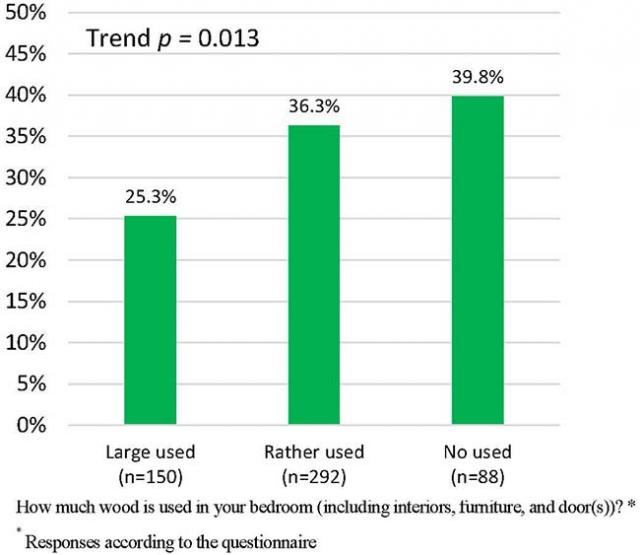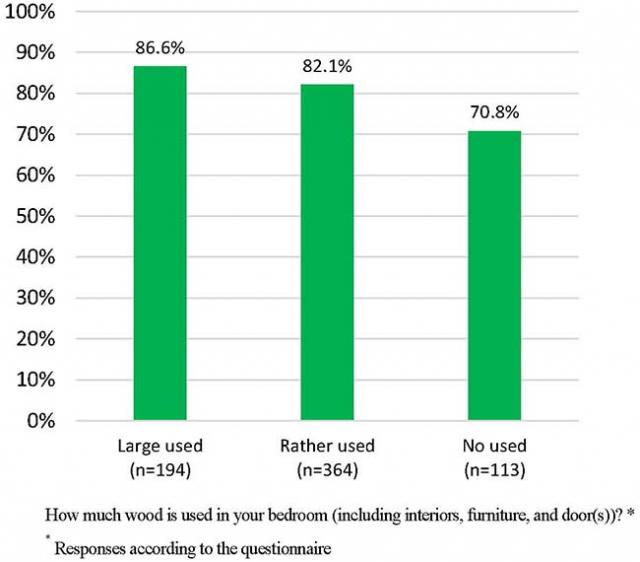Home > Research > Research Results > Research Results 2020 > Sleeping soundly with warm wooden interiors
Update:June 29, 2020
Main content starts here.
Sleeping soundly with warm wooden interiors
Less prevalence of suspected insomnia with bedroom interiors consisted of wood
| Article title |
Association of wood use in bedrooms with comfort and sleep among workers in Japan: a cross-sectional analysis of the SLeep Epidemiology Project at the University of Tsukuba (SLEPT) study. |
|---|---|
| Author (affiliation) |
Emi Morita (a)(b), Masashi Yanagisawa (b), Asuka Ishihara (b), Sumire Matsumoto (b), Chihiro Suzuki (b), Yu Ikeda (b), Mami Ishitsuka (c), Daisuke Hori (b), Shotaro Doki (b), Yuichi Oi (b), Shinichiro Sasahara (b), Ichiyo Matsuzaki (b), Makoto Satoh (b) (a) Department of Forest Management, FFPRI, Tsukuba, Ibaraki, Japan. (b) University of Tsukuba, Tsukuba, Ibaraki, Japan. (c) Teikyo University, Itabashi, Tokyo, Japan. |
| Publication Journal |
Journal of Wood Science 66(10) February 2020 DOI:10.1186/s10086-020-1852-y( External link ) |
| Content introduction |
From a survey conducted on the sleep and health of working men and women, it was found that respondents who answered that their bedrooms contained large amounts of natural/processed wood interiors, furniture, and door(s) had less prevalence of suspected insomnia, in addition to a large proportion of them feeling more comfortable. This suggests that wood materials in bedrooms may be effective for promoting sound sleep. The Forest Research and Management Organization, in collaboration with the University of Tsukuba and Teikyo University, conducted a survey about the daily sleeping habits and living environments of working people. It was found that respondents who answered that their bedrooms contained large amounts of wood including interiors, furniture, door(s), etc., had less prevalence of suspected insomnia, and a larger proportion of them felt a sense of comfort in their bedrooms. This suggests that insomnia might be relieved and people may be able to sleep more soundly by incorporating wood materials, that is, by placing wooden furniture, etc., in their bedrooms. The results of this research were published online in the February 18, 2020 edition of the Journal of Wood Science. It has been known that when people see, touch, or smell wood, their heart rate and blood pressure decrease, and their parasympathetic nerves are activated. Therefore, if they sleep in a living environment surrounded by wood, they may be able to sleep more soundly. Compared with the global average, the average sleep duration in Japan is short, with about 20% of the adult population showing symptoms of insomnia (Kim et al. Sleep. 2000). Because decreases in quality of life and work efficiency due to sleep problems including sleep disorders, lack of sleep, etc., can bring about tremendous social and economic losses, it is important to improve the sleep of working people. Multifaceted approaches from many perspectives have been taken to help people to sleep better. For example, we know that it is necessary to improve lifestyles, such as abstaining from alcohol before bedtime. However, there is very little research that has verified whether or not wood in living environments helps inducing healthier sleep, and the benefits of wood for sleep have not been fully known. Therefore, our team, a unique collaboration of specialists in forest science, sleep medicine, and occupational psychiatry (profession involved with the mental health for working people), evaluated the beneficial effects of the use of wood in living environments on sleep. From 2016- 2017, surveys were taken at 4 workplaces in Ibaraki Prefecture and the Tokyo Metropolis of 671 workers (298 males, 373 females ranging in age from 22 to 68, with average age of 43.3). The survey entailed sleep measurements by actigraphy and self-administered questionnaires. The questionnaires contained questions about the living environments including respondents' homes and their bedrooms, their sleeping conditions, and their lifestyles. This included questions about the amount of wood materials in interiors, furniture, and door(s) in their bedrooms. Furthermore, suspected insomnia was evaluated based on the Athens Insomnia Scale1. From the results of the statistical analysis of the questionnaires, the participants who responded that their bedrooms contained large amounts of wood had lower frequencies of suspected insomnia than those whose bedrooms had small amounts of wood (Fig. 1). Furthermore, the proportion of respondents with much wood in their bedrooms felt more comfortable in their bedrooms (Fig. 2). Data analysis that considered the age, sex, lifestyles, and other possible factors related to sleep conditions supported these results. Many medical studies have indicated that it is important live proper lifestyles for good sleep. However, there are many difficulties in achieving that for many people. This study suggests the possibility of an easier solution, that is, that having more wood in the bedroom might improve sleep. The present study focused on working people, but it will also be important to conduct further research on other age groups such as children, university students, and elderly people. It would also be desirable to investigate how wood can have a beneficial effect on sleep, such as its appearance, its ability to absorb sound, its aroma, and other important characteristics. More use of wood in the living environments would also help revitalize Japanese forestry, which has suffered a long recession due to shrinking consumption of domestic timber despite sufficient growing stocks in the planted forests. Explanation of terms: The Athens Insomnia Scale is a questionnaire which is commonly used worldwide to identify people who might be insomnia patients.
Figure 1 Proportion of participants with suspicion of insomnia according to the amount of wood in bedrooms.
Figure 2 Proportion of comfort in bedrooms according to the amount of wood used in bedroom interior. |
Copyright © Forest Research and Management Organization. All rights reserved.


